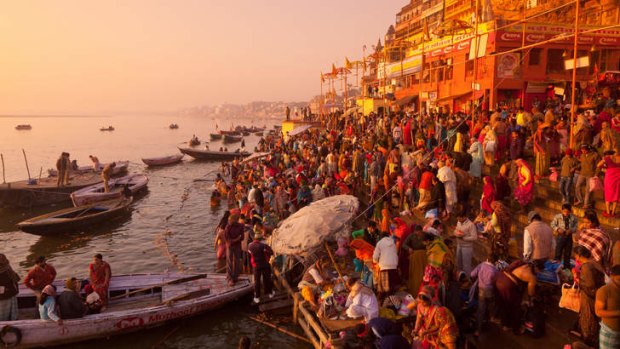
Holy dedication: pilgrims on the Ganges in Varanasi.Credit: Alamy
Julie Miller, mouth closed, searches for inner peace and a glimpse of a nation's vital soul at some of its most sacred sites.
'First, cup your hands and sprinkle the water over your head," Sarjit tells me as I take my first tentative steps into the Ganges River at the holy Indian city of Haridwar. That's easily achieved, my sarong swirling around my legs in the fast-flowing waters as I splash my face and hair.
"I suggest you dip seven times," my yoga guru and spiritual guide continues. "First to cleanse your physical, astral and causal bodies; then to cleanse all five Koshas. This will purify you of not only own karma, but also the karma of your past lives and that of your ancestors."
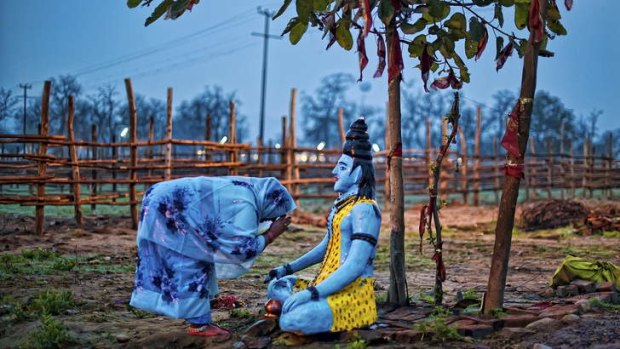
Praying to Shiva in Haridwar.Credit: Getty Images
I look at her dubiously - seven times? Surely it will be enough of a challenge taking care of my own sins without concerning myself with the misdemeanours of my forebears.
I take a deep breath, squeeze my eyes tight, hold my nose and take the plunge, trying not to think of body parts that might be floating past. The water is icy-cold, and moving so quickly I struggle to keep my footing on the slimy steps. Fortunately, a chain rail has been installed along the ghat to stop pilgrims being swept away by the current; I clutch onto it, then enjoy the jacuzzi-like sensation of the powerful flow.
But one dunking is enough; I've achieved what I set out to do, and that's to join the millions of pilgrims who bathe in the goddess Ganga - despite it being ranked among the most polluted rivers in the world. I gather my sarong and step out onto the bank, joining Sarjit and my other travelling companions with a big grin on my face. Man, it feels good to be purified, albeit superficially.
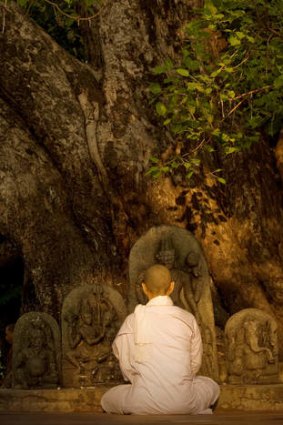
A Buddhist monk praying in front of sacred bodhi tree.Credit: Getty Images
The complexities of the Hindu religion, however, continue to baffle me, but I'm hoping my physical journey with Mantra Wild Adventures' Essential Elements tour will bring me one step closer to enlightenment as I follow in the footsteps of gods, prophets and devotees at some of India's most sacred sites. My goal is not conversion, or even a religious epiphany; rather, my quest is for a deeper understanding of Indian culture and faith, with inner peace thrown in via daily yoga and meditation lessons from Sarjit Tory, a Sydney-based yoga teacher who has joined the tour as special guest.
Known as the "Gateway to the Gods", Haridwar is one of seven holy Hindu cities, cited in legend as a place where drops of amrit, the elixir of immortality, spilled from a pitcher carried by a celestial bird. The spot where the amrit is said to have fallen, Har ki Pauri, is regarded as the most auspicious place to bathe, but every day, thousands of pilgrims gather all along the banks, with some riverside hotels - such as the charming Haveli Hari Ganga - having their own private ghats for more-exclusive bathing.
The spiritual capital of India is Varanasi, located further down river where Mother Ganga slows to a leaden, brown sludge. Here, among the chaos of one of the oldest continuously inhabited cities on earth, death is said to bring salvation; Varanasi is thereby a popular site for cremation, with millions of pilgrims descending into the river from 84 ghats to seek eternal blessings.
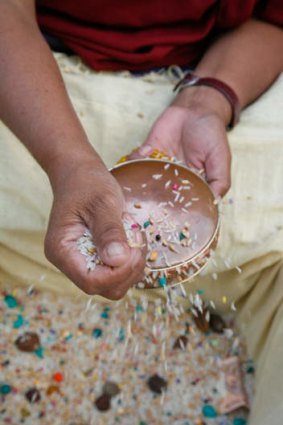
A nun in Bodhgaya spreads rice as part of a meditation practice.Credit: Getty Images
Varanasi's Ganga Aarti - a Hindu ritual performed at sunset - is a flamboyant, highly choreographed affair, attracting pilgrims and tourists alike to the banks of the Dasaswamedh Ghat or in boats on the river. Performed by a row of handsome, silk-clad Brahmin priests under floral canopies, it involves the ritualistic waving of incense, flaming lamps, gold vessels and yak-tail fans to the accompaniment of chants, cymbals, bells and conch shells. It's a mesmerising sight, the air heady with the scent of sandalwood and the collective energy of thousands of devotees.
The city of Varanasi also holds special significance for Buddhists. Just 13 kilometres away is Sarnath, the former deer park where Siddhartha Gautama Buddha gave his first sermon. The archaeological park is now considered one of four essential places of pilgrimage for devout Buddhists, with the Dhamekha Stupa the most significant and sacred building at the site. We circumambulate the imposing structure as evening falls to the accompaniment of brown-clad monks chanting in unison, their mantras adding an ethereal quality to a location already weighty with cultural and historic clout.
But it's at Bodhgaya, in the poorest state of Bihar, that I truly begin to appreciate the vitality of collective consciousness. This is where, about 2500 years ago, the Buddha achieved supreme enlightenment after fasting and meditating under a bodhi tree. An offshoot of the original tree still stands at the World Heritage-listed site, with devotees snatching up fallen leaves as they shuffle around the Mahabodhi Temple. Under the spreading limbs of the beautiful tree, monks and nuns from all around the Buddhist world sit cross-legged, reciting prayers. We join them in silence, allowing the intensely sacred atmosphere to penetrate our souls, vanquishing all skepticism to achieve that elusive inner peace that is at the core of all religions.
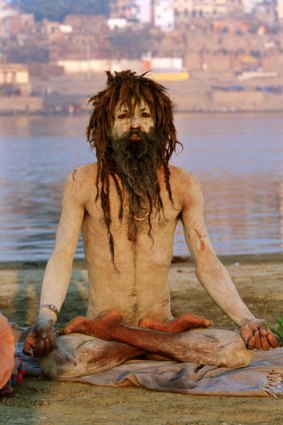
A sadhu, or holy man in Varanasi.Credit: Getty Images
My Essential Elements tour concludes with an optional add-on, which I alone of my group am taking - several days at SwaSwara, a yoga retreat three hours south of Goa at Gokarna, in the state of Karnataka. Along with Ananda Spa, in the hills above Haridwar, SwaSwara is considered one of the most exclusive spa experiences in India, offering luxury villa-style accommodation, daily yoga and meditation classes and ayurvedic therapies.
SwaSwara means "music of the soul" in Sanskrit, and this tranquil tropical resort is the perfect place to stimulate my inner rhythms. With few distractions - no television, limited internet and no travelling companions - this is my opportunity to shift the focus from the external to the internal, concluding my Indian sojourn with reflection and rejuvenation.
Guests are invited to find this inner realisation through five practices: yoga, meditation, ayurveda, cuisine and art. A five-day program includes consultations by an ayurvedic doctor, with remedies and treatments - including blissful four-handed oil massages - done throughout the week.
Holistic food is also part of the program, with delicious meals made largely from organic produce grown in the resort's gardens designed to detox and cleanse the system. Naturally enough, no alcohol or coffee is available, immediately challenging my own personal addictions.
The main activity of the retreat is yoga, with classes for every standard available three times a day. The practice is accompanied by explanatory theory, helping the largely European clientele understand the spiritual association of each posture. Beginners are also led through evening meditation classes, held under a large blue dome, unravelling the symbolism behind this foreign, mystical expression.
But it's on the resort's beach - a stretch of unspoilt golden sand significantly shaped like a Sanskrit "om" symbol - that I finally find some measure of clarity and understanding of Indian spirituality. As a soft, salty breeze blows through my hair, I stand alone facing the ocean, my only companions three horned cows, garlands adorning their necks as they meander along the shoreline. Here, these gentle bovines are at one with their somewhat incongruous environment; there is no question of belonging or sense of place, just acceptance - an attitude that dominates the Indian condition.
The moment is best summed up in the words of Buddha: "Believe nothing merely because you have been told it. Do not believe what your teacher tells you merely out of respect for the teacher. But whatever, after due examination and analysis, you find to be kind, conducive to the good, the benefit, the welfare of all beings - that doctrine believe and cling to, and take it as your guide." Amen.
Julie Miller was assisted by Mantra Wild Adventures and India Tourism.
FIVE OTHER HOLY SITES IN INDIA
The Golden Temple The holiest shrine in the Sikh religion, in Amritsar, Punjab. An ancient site for meditation, the temple (its official name is Harmandir Sahib) became the primary site of worship for Sikhs after the religion's founder, Guru Nanak, came here to worship in the 15th century.
Gangotri The origin of the River Ganges and the seat of the goddess Ganga, this is one of four sites in the Chota Char Dham pilgrimage circuit (which Hindus should visit at least once in their lifetime). A shrine is at an elevation of 3048 metres, surrounded by ashrams.
Ellora and Ajanta caves, Maharashtra These rock-cut cave monasteries and temples dating from the 2nd century are holy places for Buddhists, Jains and Hindus and contain masterpieces of early Indian wall painting.
Kushinagar, Uttar Pradesh This is where the Buddha died and achieved parinirvana. It is one of the four most important sites for Buddhists.
Ajmer, Rajasthan The most sacred of all Muslim places of pilgrimage in India. The white-domed tomb of Sufi saint Khwaja Moinuddin Chishti is here.
FAST FACTS
Getting there Singapore Airlines has a fare to Delhi from Sydney and Melbourne for about $1204 low-season return including tax. Fly to Singapore (about 7hr) and then to Delhi (5hr 45min). See singaporeair.com. Australians require a visa to visit India; see vfs-in-au.net.
Touring there A 16- or 22-day Mantra Wild Adventures Essential Elements tour, including visits to Varanasi, Bodhgaya, Sarnath and SwaSwara, costs from $4115 a person. Custom-designed wilderness, wellness and spirituality tours are also available. See mantrawild.com.au.
Further information incredibleindia.org
Sign up for the Traveller Deals newsletter
Get exclusive travel deals delivered straight to your inbox. Sign up now.